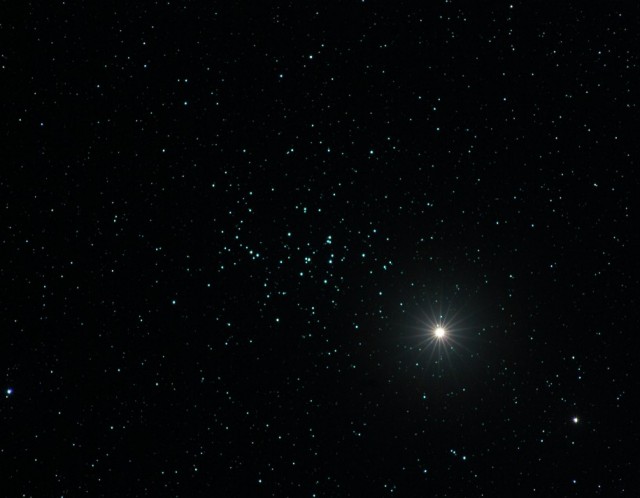
|
Credit & Copyright: Jimmy Westlake
(Colorado
Mountain College)
Explanation:
If you can
find Saturn in tonight's sky, then
you can also find M44,
popularly known as the Beehive
star cluster.
In fact, with a pair of binoculars most casual skygazers should
find it fairly easy to zero in on this
celestial scene.
Saturn is at
opposition - opposite the Sun
in Earth's sky - so, the bright planet rises in the east at sunset
and is visible throughout the night.
Near the
stationary part of its wandering path through
the heavens, Saturn will obligingly linger for a while
in the vicinity of M44 in the relatively faint
constellation Cancer.
Seen here in a photograph from January 25, Saturn (lower right)
is strongly overexposed with the stars of M44 swarming above
and to the left.
The picture approximately corresponds to
the view when looking
through a typical pair of binoculars.
Saturn is
about 64 light-minutes from our fair planet
while M44, one of the closest star clusters, is around
600 light-years away.
|
January February March April May June July August September October November December |
| |||||||||||||||||||||||||||||||||||||||||||||||||||||||
NASA Web Site Statements, Warnings, and Disclaimers
NASA Official: Jay Norris. Specific rights apply.
A service of: LHEA at NASA / GSFC
& Michigan Tech. U.
Based on Astronomy Picture
Of the Day
Publications with keywords: M 44 - beehive cluster - open cluster - star cluster
Publications with words: M 44 - beehive cluster - open cluster - star cluster
See also:
- APOD: 2025 August 7 Á The Double Cluster in Perseus
- APOD: 2025 July 4 Á NGC 6946 and NGC 6939
- Young Star Cluster NGC 346
- APOD: 2025 April 28 Á Gum 37 and the Southern Tadpoles
- Open Star Clusters M35 and NGC 2158
- APOD: 2025 February 25 Á M41: The Little Beehive Star Cluster
- APOD: 2025 February 11 Á The Spider and the Fly
